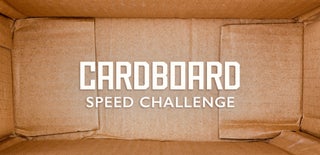Introduction: Interactive Recycling Cardboard Bins
In response to the Inscrutable's cardboard speed challenge, time to pull out my specialty. Yes, you've guessed it, cardboard! Let's go all out "Green" today!
This cute little project that I did with my fiancee was inspired by the Fun Theory's World's Deepest Bin, we have created a cardboard recycling bin as a tiny showcase for iLight @ Marina Bay, Singapore's most exciting lighting art festival. Well.. it was a small feature, nonetheless I find it amusing and really functional!
Here's a repository on how to design this project and please, share some love and give us a thumbs up! This project deserves some attention haha!
For more educational materials, visit my channel:
https://www.youtube.com/channel/UC7_GBbygzIDpgijsR...
Design Objectives:
Making recycling fun and interactive to encourage more people to do seemingly mundane but important collaborative tasks. Using design to change social behaviors for the better.
Supplies
Per Bin (Structural):
- 3 x 600mm x 400mm Corrugated Cardboard Sheets (2Ply:~6mm)
- 1 x Lacquer/Varnish
- 1 x Paint Brush/Roller (Wider better)
- 1 x Hot Glue Gun
- 1 x Pen-knife
- 1 x Foam
Per Bin (Electronics):
- 2 x Mini-Breadboards
- 1 x Tiny Speaker (USB)
- 1 x Power Bank/Power Supply (5V-12V)
- 1 x Arduino Uno
- 1 x Cytron MP3 Shield
- 1 x SD Card (+Music Files)
- 1 x Sharp IR Sensor
Step 1: CAD/Design Your Bin
Roughly sketch out how your bin will look like. In this design there are 2 sections to the rubbish bin - the head and the body. The largest dimensions of the head/body is 56cm by 56cm. The total height of the entire bin is about 95.4cm or 1 metre tall. Based on the proportion for my design, head:body ratio will be 1:2.5. I have created a taper from the base to the top to create a more organic like shape that is not that "dead-looking". It also helps with having a wider top to ensure most of the rubbish goes into the bin.
To make it easy (since you are going to glue gun everything), cut out 4 tapered rectangular faces and join them together with a piece of cardboard at each corner. Although, I have lost my CAD in my hard-disc but you get the point.
Step 2: Waterproof the Bin
As the bin will be placed in an open area and not all participants are nice, we need to ensure that the bins are waterproof or resistant. To achieve that, we applied 3 layers of lacquer with 1 hours rest per application for the layer to dry out.
Next, we ran the material through running water and look out of any forms of absorption. It works. This is a pro-tip, if you like it, give us a thumbs up!
Step 3: Inserting the Electronics
There are a few functions of the bin that we want it to do:
- Play an audible sound (surprise)
- Light up the interior (surprise)
- Ability to detect rubbish thrown
- Able to run for 4 hours straight in idle mode
- Easily replaceable parts
To do that, we bought a 5V-USB mini laptop speak and found it to be loud enough as our speakers. To reduce the amount of vibration on the head, we included some sponge to dampen the vibration. We then add in some simple LED diodes to 4 corners of the bin. We waterproof the leads with gluegun.
To detect any rubbish that is thrown, we have added an IR sensor on the top of the entrance of the bin so that if things are coming into the bin, we are able to execute various outputs to stimulate the users' sensors.
The central to this entire system is an Arduino Uno with a MP3 Shield that have all my songs stored into it. We have "Rubbish belongs in the rubbish bin" children song as well as the classic decrescendo to illustrate a long drop.
To avoid interfering with the rubbish and keeping things discreet, we have hidden everything under the head. As the setup might be heavy, we have secured it firmly onto the head with velcro. The entire system is powered by a 5V wall adapter. This will definitely last more than 4 hours!
RIP: Tons of glue gun.
Step 4: Decorating the Bins
Now that everything is in place. It's time to replicate the bins and make it look like a bin! To do that, my wonderful fiancee had cutout sheets of paper and sketched out some icons and logos with a piece of permanent marker. We then laminate these sheets and cut them into sizes.
Once again, we glued the pieces onto the bodies of the bins and the rest is history. It's showtime!
Step 5: Finished Product
Throughout this journey, we have learnt a lot on cardboard-making as well as have enjoyed the time with each other. We believe that making and building stuff is most fun when you work as a team and when you are working for the greater good.
I am grateful that this cardboard speed challenge have spurred me to document all these things online.
Please consider voting for this Instructable in the Cardboard Speed Challenge. Thanks!
"Rubbish belongs in the rubbish bin.
So pick it up and throw it in.
We can enjoy a world that's clean.
If we do our part,come on,make a start.
Chorus:
Plastic bags, bottles and cans half-eaten food,all covered with ants.
Let's see who can feed more thrash.
To Billy the rubbish bin.
Rubbish belongs in the rubbish bin.
So do what's right and throw it in.
We can enjoy a world that's clean.
For you and for me, let's do it cheerfully(chorus).
So throw that rubbish in. Into the rubbish bin. Come on, let's all join in. Throw that rubbish in!"

Participated in the
Cardboard Speed Challenge













